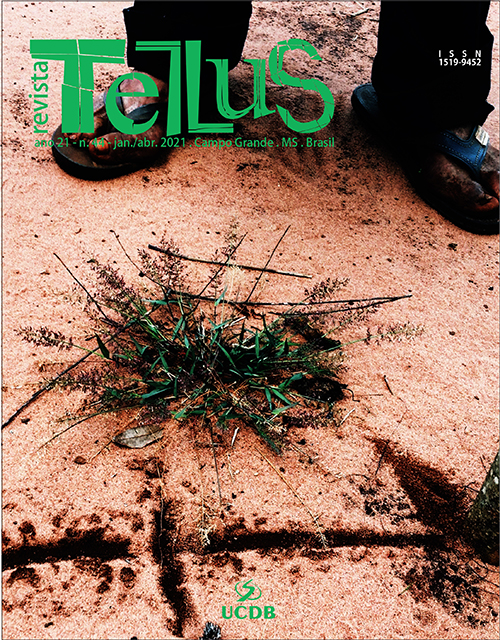Amazonia’s indigenous peoples: from the canoe path to the reframing of cultures and languages
DOI:
https://doi.org/10.20435/tellus.vi44.726Keywords:
sociolinguistics, amazonian culture, linguistic trunk, reframingAbstract
This paper reports on the experiences of indigenous peoples in Amazonia about construction and use of bũgu (tree trunk hull) and igara (wooden canoe) vessels since the arrival of the first civilizations in the amazon region and after these, the evolution which occurred in the construction of large vessels such as igarité (boat) and igaritéasu (ship) with the arrival of Europeans. Later, we did a brief analogy between the tree trunk and the linguistic trunk relating to the indigenous peoples who lost their mother tongues and assimilated Nheengatu as an ethnic language. The methodologies used was ethnography. This research is part of the ongoing doctoral project: The sociolinguistic and literacy situation in Nheengatu of indigenous students and teachers from municipal schools in Manaus, whose objective of this work was to contextualize the socio-cultural aspects to the sociolinguistic situation of these peoples from their experiences from day by day experiences to the process of acquisition and use of the Nheengatu language making a brief analogy between the term tree trunk and the term linguistic trunk. The study found based on the socio-cultural context that indigenous peoples have built and used the bũgu since their early generations, which is part of their culture and is used as the main means of transport in the rivers ygarapé (canoe path) of the Amazonia, and in the sociolinguistic context we found that the Baré, Mura and Warekena peoples lost their first mother tongues and assimilated the Nheengatu language and the brazilian portuguese language.
References
BAGNO, Marcos. Dicionário de sociolinguística. São Paulo: Parábola, 2017.
BANIWA, Augusto. Imagens de canoas do rio negro. 2020. 1 fotografia.
CARADINA, Gabriel. A evolução do transporte. São Paulo: Conjovem, 2019.
CARVALHO, Paulo Ernani Ramalho. Espécies arbóreas brasileiras. Brasília: Embrapa, 2003. v. 1
CAVALIER-SMITH, T. A revised six-kingdom system of life. London: Cambridge University Press, 1998.
CENATTI, Márcio José. Homem: ser de transcendência. São Paulo: Ixtlan, 2013.
COLOMBO, Cristovão. Diários de descoberta da América: as quatro viagens e o testamento. Tradução de Milton Persson. São Paulo: L&PM Pocket, 1984.
CORDEIRO, Florêncio; LIMA, Ademar dos Santos; CRUZ, Aline; CASTRO, Ana Júlia Miranda; SOUSA, Rosineide Magalhães. Mayé yamunhã bũgu: uma abordagem sociolinguística sobre a origem do casco de madeira. Brasília: Cambridge Open Engage, 2020.
DAVIES, Douglas. The evocation symbolism of trees. In: COSGROVE, Denis; DANIELS, Stephen. (Ed.). The iconography of landscape: essays on the symbolic representation, design and use of past environments. Cambridge: University Press, 2002; p. 32-42.
GIL, Antônio Carlos. Métodos e técnicas de pesquisa social. 5. ed. São Paulo: Atlas, 2006.
HYMES, Dell. Foundations in sociolinguistics: an ethnographic approach. Philadelphia: University of Pennylvania Press, 1972.
IBGE. Panorama de Manaus. IBGE, [s.l.], [s.d.]. Disponível em: http://cod.ibge.gov.br/3WL. Acesso em: 29 out. 2020.
ISAIAS. Sagrada Bíblia Católica: Antigo e Novo Testamentos. Tradução de José Simão. São Paulo: Sociedade Bíblica de Aparecida, 2008. 1118 p.
JUNG, Carl Gustav. O homem e seus símbolos. Rio de Janeiro: Nova Fronteira, 1995.
KANT, Emmanuel. Crítica da faculdade do juízo. 2. ed. Rio de Janeiro: Forense Universitária, 2005.
LEWIS, Alice Carrol. Landscape in the Mind. In: RODBELL, Phillips D. (Ed.). Proceedings of fourth urban forestry conference. Missouri: The American Forest Association, 1990.
NÉMETH, Peter Santos. O feitio da canoa caiçara de um só tronco: a cultura imaterial de uma nação, em 25 linhas. São Paulo: Instituto Costa Brasilis, 2011. (Dossiê)
PAIVA, Vera Lúcia Menezes de Oliveira. Manual de pesquisa em estudos linguísticos. São Paulo: Parábola, 2019.
PROFESSORES INDÍGENAS (P1; P2; P3; P4; P5). Gravação de conversas e narrativas. [jul. 2016]. Pesquisa de observação participante: Ademar dos Santos Lima. Manaus, 2018. 1 arquivo .mp3 (90 min.).
PUREMANÃ, Kim. Fotografias dos cascos do Tarumã Açú. 2020. 2 fotografias.
QUEIXALÓS, Fancesc; RENAULT-LESCURE, Odile. (Org.). As línguas amazônicas hoje. São Paulo: Instituto Socioambiental, 2000.
RODRIGUES, Aryon Dall'Igna. Línguas brasileiras: para o conhecimento das línguas indígenas. São Paulo: Edições Loyola, 2013.
SOUZA, Rafaela. Biomas brasileiros. Brasil Escola, [s.l.], [s.d.]. Disponível em: https://brasilescola.uol.com.br/brasil/biomas-brasileiros.htm. Acesso em: 19 jul. 2020.
STEEGE, Hans ter; PITMAN, Nigel; SABATIER, Daniel. Hyperdominance in the Amazonian tree Flora. Science, Exeter, v. 342, n. 6156, p. 29, 2013
TARALLO, Fernando. A pesquisa sociolinguística. 7. ed. São Paulo: Ática, 2003.
WUNENBURGER, Jean-Jacques. La vie des images. Grenoble: Presses Universitaires de Grenoble, 2002.
Downloads
Published
How to Cite
Issue
Section
License
Todos os artigos publicados na Revista Tellus estão disponíveis online e para livre acesso dos leitores, tem licença Creative Commons, de atribuição, uso não comercial e compartilhamento pela mesma. Direitos Autorais para artigos publicados nesta revista são do autor, com direitos de primeira publicação para a revista. Em virtude de aparecerem nesta revista de acesso público, os artigos são de uso gratuito, com atribuições próprias, em aplicações educacionais e não-comerciais.


